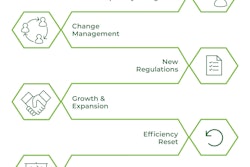As a grain facility/feed mill owner, manager or maintenance head, your primary role is to keep your operation running dependably and safely in a profitable manner. You know all too well that your day-to-day responsibilities are more than enough to keep you busy.
So when a decision is made to expand your facility grain storage, you are faced with a multitude of decisions that need to be made. While it is nice to think that you can simply hire a contractor and go on with your everyday duties, the reality is that your active input in the decisions being made during the design and construction process can and will pay long-term dividends for your operation.
There are many things to consider when it comes to the expansion/installation of your new grain storage electrical system. Here are a few:
1. If adding on to an existing facility, can I power the expansion from my current electric gear? The following are some items to consider:
- What is the age and condition of the gear?
- Does the existing gear comply with current electrical codes?
- Does the equipment have proper arc flash labels?
- Is the existing gear operating at the voltage level required by the new equipment?
- Does the existing gear have extra capacity that can power the new expansion?
- Is the existing gear so far away from the new expansion that a new, separate electric service should be installed closer to the storage expansion?
- Will this additional load negatively affect my facility power factor or electrical demand and thereby increase my monthly electric bill?
- At what horsepower rating does the utility require reduced inrush starters (i.e. soft starts or variable frequency drives)? Is my current electrical gear able to accommodate these types of motor starters?
- Should I consider the use of aluminum conductors in order to save on construction costs?
- What options do I wish to have built in to my new motor starters?
- Does my existing gear have surge protection built into it? If so, what level of protection?
2. If the decision is made to install a new electric service to serve the storage expansion, the following are some additional items to consider:
- Will the electric utility provide a new transformer at the location of the new bin storage?
- What charges might the electric utility assess for this new service?
- Am I adding enough load to get the utility to waive or minimize their charges?
- What sort of a contract will the electric utility require me to sign?
- Should I consider having my load metered on the utility side of the power supply (i.e. primary metering)?
- What brand of new electric gear should I request/be chosen?
- Who will perform the short circuit/coordination/arc flash study on my new electric system?
- Should I use electronic trip circuit breakers instead of traditional thermal magnetic breakers?
3. Electrical hazards to consider include the following:
- What areas of the new storage expansion are to be considered as Class II, Division 1 hazardous environments because of combustible dust?
- What areas of the new storage expansion are to be considered as Class II, Division 2 hazardous environments because of the presence of combustible dust?
- What are the arc flash hazards at the various pieces of electric gear?
- 我希望有一个地方电断开each motor location or do I lock out at the motor starter and use lock out tag out?
- Are my employees trained on potential electrical hazards?
4. Regarding the selection of motors, the following should be given consideration:
- Which areas require motors listed for use in dusty, Class II (hazardous) environments?
- All new motors are now required to have a premium efficiency rating. So, if you are trying to decide whether to continue to use a standard efficiency on an existing motor load or replace the motor with a new premium efficiency motor, keep in mind the energy savings that you will experience with a premium efficiency motor. Depending on the type of load and the amount of time that it runs, the cost savings can be significant.
- Which motor loads should be served by an adjustable speed drive (ASD) [more commonly known as variable frequency drive (VFD)] for speed control purposes? Note that conveyors and leg motors can be excellent candidates.
- VFDs on leg motors can eliminate the need for separate creeper motors for the purpose of inspecting buckets.
- VFDs on conveyor motors allow you to better balance the flow of grain to other conveyors, legs, etc.
- Which motor loads should be served by a VFD for energy saving purposes? Note that fan motors have an excellent potential for energy savings.
- VFDs on fan motors also reduce fan noise.
- VFDs on fan motors also allow for better control of airflow through grain.
- 这应由变频电机负载再保险吗duced inrush starting purposes? Note that elevator legs are an excellent candidate for reduced starting inrush current.
- VFDs offer the advantage of 100% torque on start up. This can be helpful if you are ever faced with the situation of starting a elevator leg when it is fully loaded.
- Should I require a by-pass contactor on my VFDs?
- How critical is this motor to your operation? A bypass contactor allows you to still operate the motor in the event that the VFD fails.
5. Regarding the selection of light fixtures, the following should be given consideration:
- Which areas require light fixtures listed for use in dusty, Class II (hazardous) environments?
- Are there governmental regulations in place that will require compliance with particular energy codes?
- Should I ask for LED lighting in lieu of metal halide or fluorescent lighting?
6. Regarding the selection of light fixtures, the following should be given consideration:
- What is the age and condition of my existing control system?
- Is my existing process control system capable of being expanded to accommodate the new storage expansion?
- Does system expansion require that I use the original control system integrator?
- Do I want to update my control system to have the latest hardware and software?
As you can see, the amount of decisions that need to be made regarding your electrical systems can be intimidating.
But as daunting of a task as this may all seem, you may be tempted to just let your general contractor handle it. He will likely turn to his electrical subcontractor for help in resolving these issues.
While that might work for a simple one- or two-bin expansion, it may not work well on larger projects. After all, a contractor is often having to compete for your work as part of a competitive bidding process.
If there is little-to-no guidance on issues like those identified above, the contractor is usually forced to choose the least-cost option in order to remain competitive. While a least-cost approach upfront may be appealing, it can have a detrimental impact on your long-term facility operation and maintenance costs.
Yes, the list of decisions that need to be made is long. Despite this, get involved.
Someone will ultimately have to make decisions like these. Shouldn’t that person be the one who will have to work with the consequences of the decisions? ■
Mark Joffer is president of PE Group, Inc. Electrical Consulting Engineers. Joffer has over 30 years’ experience as an electrical design engineer and is a registered professional engineer in more than 20 states. His background also includes licensure as a Journeyman Electrician as well as a state Electrical Inspector. Joffer has spent much of his career specializing in the design of electrical systems for environments made hazardous by the presence of combustible dusts. He is a 1985 graduate of South Dakota State University with a Bachelor’s degree in Electrical Engineering.





















